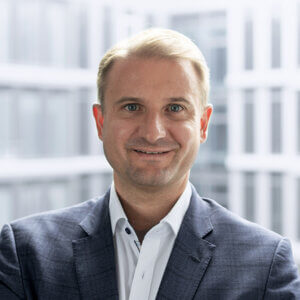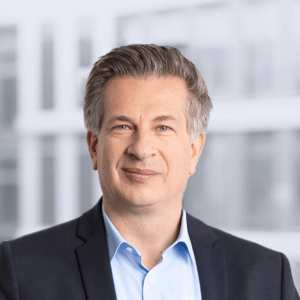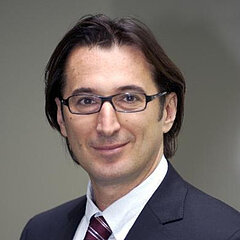Interview with the management Philipp Oberleitner and Martin Feith


Financial service providers have mastered some challenging tasks in recent years by reconciling falling margins and increasing demands on end customers with automation and digitalization. This balancing act was only made possible by increasingly powerful IT systems. Many credit or leasing providers have opted for partnerships with IT service providers in order to remain successful in a rapidly evolving world. These customer relationships have existed for many years and have survived many changes and technological advances.
If you look at the large financial services market, especially the areas of credit, leasing and factoring, IT providers in German-speaking countries are generally highly specialized technology companies. In addition to a few global players, it is mainly medium-sized IT companies that have developed over the years in line with their customers' requirements. As an employee of an IT provider of this type, you always encounter the same competitors, for example at association events. This was also the case for many decades for the employees of NAVAX and afb Application Services. But now the signs have changed, as afb Application Services has been part of the NAVAX Group since the end of 2022. The result is a strong player in the market with around 310 employees and more than 160 specialists working in the financial services sector. An interview with the management of NAVAX FSI reveals what the first few months in the "same team" feel like.
1) The first 100 days since the merger have now passed. In politics, the very first interim conclusion is drawn after 100 days and the mood is surveyed. We want to do the same with you now. How have the first few days gone and what is the mood like?
Philipp Oberleitner: It was an exciting time and an exciting experience. At afb, I have been responsible for the success of our customers for many years as a divisional director. It was amazing to see how quickly we were able to act together on the market and communicate the added value of the merger to our customers. One might assume that after a merger it takes many months to prepare everything internally before we can really work the market together. That wasn't the case here at all. After a very short time, we held joint customer meetings, submitted joint offers and worked together as a team. It all happened very quickly and was more positive than I would have expected.
Martin Feith adds: " Yes, that's how I see the first few days. I think the fact that the collaboration went very smoothly right from the start was due to the fact that the cultures of the two companies are very similar. It was a pleasure to discover that afb also employs hands-on, practice-oriented and authentic people. This is exactly what I was used to for years as Managing Director of the NAVAX FSI division. Of course, there is a lot of work in addition to the daily tasks. But many people are experiencing a merger for the first time in their professional lives and find it extremely exciting. The motivation to be able to be creative ensures that the additional workload is manageable for our key players.
2. You have now been allies for 100 days. Before that, you were - at least indirectly - adversaries for decades. How well did you know the other company beforehand?
Martin Feith: We didn't know each other personally beforehand. In business terms, our knowledge was limited to the usual: We met at the events, which were manageable after all, such as the association conferences. Or occasionally we were at the same tender.
Philipp Oberleitner: Yes, that's exactly how I see it. As a rule, our contracts are awarded exclusively through elaborate tendering or evaluation phases. We have sometimes noticed that the other party was also involved in the bidding process.
3. Despite the supposed competition, what you say doesn't sound as if you were at loggerheads beforehand. So there was no fear of contact?
Philipp Oberleitner: No, there was no fear of contact at any level. Whether in top-class sport or in business - it's completely normal to suddenly become part of a team that was previously the "opposing" team. How you feel personally is also important. After all, despite all the rational pro arguments for a merger, the employees have to feel comfortable at the end of the day. For my part, I feel very comfortable after the first 100 days.
Martin Feith: There was no skepticism on my part either. On the contrary: the fact that we are already on site together with our customers means that it quickly became clear during the appointments that we now have real support. That's a good feeling. Incidentally, it's always amusing to discover that the team of your former opponent has faced challenges of a similar nature to your own. You often find that the other person has solved the same problem in a way that you wouldn't have thought of yourself. It's great that we can now bring this expertise together. In these moments, I sometimes think to myself: "Aha, here it is, the famous added value that is always propagated in company mergers. It's not just an empty slogan, it really exists. Of course, there are also differences of opinion on several topics. But these are discussed and resolved amicably in a constructive and friendly atmosphere with a view to finding the best solution for our customers and employees."
4. Strength is a good keyword: What strength of the other company has impressed you the most so far?
Martin Feith: afb has an excellent reputation among financial service providers in the German market. They were able to strategically expand their roots in the highly efficient automotive business in two ways: Firstly, the car loan business has always been a market that could only be processed profitably with a high degree of automation. This need for automation has repeatedly forced afb (through customer requirements) to enable a high degree of digitalization for the processes. And there is a second aspect that I see: The car loan market, which is characterized by strong manufacturers, taught afb at a very early stage that as an IT service provider you have to keep an eye on more than "just" the bank or the leasing company. Their way of working is geared towards understanding the entire ecosystem surrounding the loan, leasing or factoring contract. In addition to the financial service providers, manufacturers, retailers, service providers and, of course, the end customer all play a decisive role. This is precisely the perspective that is crucial for the future, as more and more companies in the financial services sector are also keen to establish their own ecosystems. Of particular interest to our existing customers are afb's cloud services and the many additional modules available for the financial services sector.
Philipp Oberleitner: The organizational size and spread is something that is immediately noticeable and perceived as a boost. Our solutions together are now also becoming interesting for large corporations, for which we may have been too small in the past. With NAVAX, we can have a greater impact and deliver end-2-end solutions quickly and easily, from a CRM system and financial ERP to a data warehouse. The NAVAX Group is present in numerous sectors with its MS Dynamics solutions and therefore also maintains contacts with product manufacturers for whom the topics of leasing, credit and factoring could also be of interest. As NAVAX FSI, we benefit enormously from this expertise and these contacts.
5) What you have just described depends largely on the IT system / IT product that you have "in-house". The merger of NAVAX with afb means that there are basically two playing fields: NAVAX is associated with HENRI, while afb is primarily associated with afb-CMS. How will you deal with these two technology bases in the future?
Philipp Oberleitner: Both will definitely be retained and expanded. Each product offers specific advantages and can be optimally complemented by the open technologies of the other.
Martin Feith: Yes, that is a huge advantage for our customers. There are many new opportunities for our joint existing customers and both technologies are being consistently developed further, taking into account synergy effects that bring improvements and optimizations etc. for our customers.
6. This answer was not really to be expected. After all, you both offer Front, Middle and Back office solutions, are aimed at retail, leasing and factoring providers and can therefore cover automotive, investment financing and other areas of financing, including real estate. Doesn't it make sense to continue developing just one system in the future?
Martin Feith: There are indeed important similarities. Both enable the complete digitalization of Front, Middle and Back office processes. Different technologies are used and our customers will continue to have the option of purchasing a complete solution for all processes of a leasing, factoring or property financing company or to ideally supplement an existing system landscape with our modular products. We also proactively advise our customers on the optimum architecture and technology for their requirements. But if you take a closer look, you will understand that all the similarities can be interpreted as cornerstones and that there are differences in the details that complement each other perfectly. In short: what unites us is our deep understanding of the industry and our ability to think in terms of solutions.
Philipp Oberleitner: To understand the complementary effect of HENRI and afb-CMS, you have to delve a little deeper. Despite all its configurability, HENRI is designed more as a system that can be quickly introduced to a customer as a whole. This is also possible with the afb-CMS (Credit Management System), but many of our customers use our solutions in the form of several individual modules, which are then seamlessly integrated into the customer's system landscape. In this way, we can jointly offer the modernization of existing solutions in all forms (incremental, holistic, partial).
7 HENRI or CMS: Which architecture do you recommend to your customers and what does the right choice depend on?
Philipp Oberleitner: That depends very much on the customer's needs. That's the great thing. We can now focus even more on the customer's wishes, their strategy, their IT landscape and their organization. And we can even design solutions that combine the strengths of both architectures. It is therefore conceivable that both products could be used in an overall solution for a customer. For example, quotation calculation and application processing could be orchestrated via the CMS, while contract management and accounting could be handled within HENRI. We also offer shared services. These are small partial solutions that customers can easily integrate into their existing IT landscape to close gaps there.
Martin Feith: Let's take an example. Imagine you are an industrial company. We have just noticed that this manufacturer is not only driving forward the production of its products and the associated services, but is also increasingly taking the initiative to enrich its products with financial products, e.g. leasing of capital goods. To this end, it is setting up its own leasing companies along the lines of captives in the automotive sector. If this manufacturer already uses MS Dynamics in its other divisions, then this could be an argument for using HENRI, which is also based on MS Dynamics, in the Back office for this manufacturer. Conversely, other initial constellations could speak in favor of the manufacturer-independent afb-CMS. In this way, we design the entire value chain optimally for the customer. As mentioned above, we focus on the optimal solution architecture for the respective customer and draw on our wide range of solutions and technologies.
8. As you describe the first 100 days, there seems to be a noticeable added value in practice with regard to the two IT architectures. What about your other services, such as consulting?
Martin Feith: Together, we have a large team of experienced consultants in a wide range of specialist areas. In future, we will be able to offer our customers a much wider range of services and benefit greatly from each other's wealth of knowledge and experience. To differentiate: Many IT providers offer consulting services tailored to their solutions. However, this is usually reduced to recording the customer's needs in order to ensure optimum advice on product specification. But NAVAX masters customer processes so well that customers can also benefit from our specialist and process consulting.
Philipp Oberleitner: As Martin mentioned at the beginning of one of the previous questions, we were focused at a very early stage on integrating the influences of other players in the financing services ecosystem into our solutions in addition to the needs of the financial services provider. From this mixed situation, a need for advice emerged in many respects. If you add the pressure to innovate that financial service providers are under, they also need support here. We have always emphasized this overall package of IT and consulting in the sense of a strategic, innovation-oriented partnership with our customers. In view of this, we have always seen ourselves as a business innovation and transformation partner - and not just as a software provider.
9. Do customers not control their own processes? What's more, if it has occurred to product providers to integrate financial services into their offering, then they have already been doing so for a long time. After all, this approach has been practiced by automotive captives for decades. Why is consulting for your IT solutions currently so important?
Philipp Oberleitner: Of course the customers have mastered their processes. But as the saying goes: "The better is the enemy of the good". They, too, always come to the point where they want to improve further. This is where we can help. And you are of course right about advising non-financial service providers. It is indeed the captives you mentioned that embody this idea. They have a long tradition in the automotive market because it is simply a large market with a lot of power. Today, this is expanding into many other sectors, such as equipment finance.
Martin Feith: Exactly, Philipp mentioned the right keyword here. The equipment finance sector is a prime example of how this approach, familiar from the automotive sector, is also taking place in sectors with even more complex goods and less automation. Manufacturers of industrial goods are currently starting to do this, for example by setting up their own leasing companies. This is due to many trends that are currently interacting. We have tried to avoid using buzzwords in this interview. But at the end, I will take the liberty of mentioning the trends with the relevant words: Customer centricity, embedded finance, circular economy, servitization, Industry 4.0 and, of course, digital transformation.
10 Ok, ok... Explaining how these trends interact seems to provide enough material for a second interview. Finally, a brief personal question: Vienna and Munich have a lot to offer and are comparable in some respects. Have you had the opportunity to get to know the typical events in each country? Which events have impressed you in this respect and which are you looking forward to?
Martin Feith: I have known and appreciated beautiful Munich for a long time and always enjoy coming here, both professionally and privately. The next highlight in this regard, apart from the current appointments and coordination, will of course be the joint visit to the Wies'n with the new large NAVAX team.
Philipp Oberleitner: Yes, just like the last few years, afb will not miss it. I was already able to attend the Christmas party in Vienna. I was impressed by how warmly and lovingly an event of this size can be organized.
Martin and Philipp, thank you very much for talking to us!

